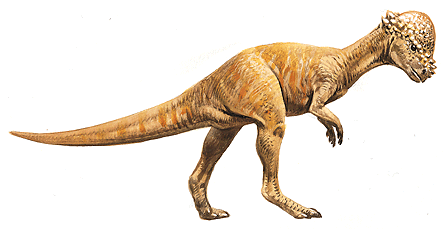Just Thick Headed
May 10, 2013
Scientists from the Royal Ontario Museum in Canada have reported the discovery of a new pachycephalosaur in the Canadian province of Alberta in the Milk River formation. The discovery was based upon two fossil skulls.

Pachycephalosaurs all had thick skulls. (World Book illustration by John Francis, Bernard Thornton Artists)
Pachycephalosaur means thick-headed lizard. The new specimen of this plant-eating dinosaur, named Acrotholus audeti, is the oldest known North American pachycephalosaur and may be the oldest ever found. Pachycephalosaurs lived in western North America and Asia during the late part of the Cretaceous Period (a time in Earth’s history from about 145 million years ago to 65 million years ago). They had extremely thick skulls, often covered with bumps and spikes. Some scientists believe that pachycephalosaurs used their heads in butting matches, much as male bighorn sheep do today. Other scientists believe the thick, knobby skulls could have served a decorative purpose.
Acrotholus—which means high dome—was a small dinosaur. At about 80 pounds (36 kilograms), Acrotholus was the size of a large dog. Small dinosaurs are not as common in the fossil record, and scientists do not know if that is because there were fewer small dinosaurs or if the fragile bones of smaller dinosaurs did not fossilize as well. This is less true of pachycephalosaurs, however. Whether their heads were for fighting or showing off, their thick skulls, with nearly 4 inches (10 centimeters) of bone, were less likely to be scattered or washed away before a fossil could be formed.
Other World Book articles:


